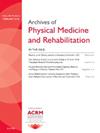2001 年至 2017 年期间在军队医疗系统接受治疗的成人在主要肢体缺失后的门诊康复利用情况。
IF 3.6
2区 医学
Q1 REHABILITATION
Archives of physical medicine and rehabilitation
Pub Date : 2025-03-01
DOI:10.1016/j.apmr.2024.09.017
引用次数: 0
摘要
目的调查与肢体严重缺失的军事医疗系统(MHS)受益人门诊康复就诊相关的风险:设计:回顾性队列研究:美军治疗机构和接受 TRICARE 福利的民用医疗机构:干预措施:不适用:主要结果测量指标:这项探索性分析调查了患有重大肢体缺失的医疗服务受益人的门诊康复护理与人口统计学和截肢特征之间的关联:在 5,161 名患有重大肢体截肢的军人受益人中,大多数人的年龄在 55-64 岁之间(36%),男性(73%),退休人员/家属(60%),拥有入伍赞助军衔(88%),单肢截肢(89%)。现役/后备役受益人更年轻,男性居多,更有可能被诊断出有行为健康问题。未经调整的负二项回归模型显示,与退休人员/家属相比,ADSM 的门诊康复就诊率更高(比率比 (RR),10.02,95% 置信区间):10.02,95% 置信区间 (CI):9.30, 10.80)。按受益人类别分层后,性别、担保人级别、肢体缺失、事件行为健康状况、事件创伤性脑损伤、事件创伤后应激障碍和门诊护理环境的比率比有所降低。与军官相比,入伍的 ADSM 门诊康复治疗天数增加,而与军官相比,有入伍担保人的退休人员/家属的门诊康复治疗天数减少。与只在个人医疗机构就医的 ADSM 相比,在 DC 和个人医疗机构接受门诊治疗的 ADSM 的门诊康复就诊率较高(RR:4.60,95% CI:2.95, 6.81):这项研究表明,有严重肢体缺失的医疗服务受益人在使用门诊康复服务时,会因现役/后备役或退休/家属身份而有所不同。这项研究是首次对各种原因导致的重大肢体缺失的军人受益人的门诊康复利用情况进行量化的同类研究,可为医疗服务系统决策者提供有关战斗和非战斗相关截肢人群康复需求的信息。本文章由计算机程序翻译,如有差异,请以英文原文为准。
Outpatient Rehabilitation Utilization After Major Limb Loss in Adults Receiving Care in the Military Health System From 2001 to 2017
Objective
To investigate exposures associated with outpatient rehabilitation encounters among Military Health System (MHS) beneficiaries with major limb loss.
Design
Retrospective, cohort study.
Setting
American military treatment facilities and civilian health care facilities that accept TRICARE benefits.
Participants
Adult MHS beneficiaries with major limb amputation(s) acquired between January 2001 and September 2017 (N=5161).
Interventions
Not applicable.
Main Outcome Measures
This exploratory analysis investigated associations between outpatient rehabilitation care and demographic and amputation characteristics in MHS beneficiaries with major limb loss.
Results
Most beneficiaries were aged 55-64 (36%), male (73%) and retirees/dependents (60%) with enlisted sponsor rank (88%) and single limb loss (89%). The active/reserve beneficiaries were younger, majority male, and more likely to be diagnosed with incident behavioral health conditions. Unadjusted negative binomial regression models revealed increased rates of outpatient rehabilitation encounters in active-duty service members (ADSMs) than in retirees/dependents (rate ratio, 10.02; 95% confidence interval, 9.30-10.80). The rate ratios for sex, sponsor rank, limb(s) lost, incident behavioral health condition, incident traumatic brain injury, incident posttraumatic stress disorder, and outpatient care setting were attenuated after stratification by beneficiary category. Enlisted ADSMs had increased rates of outpatient rehabilitation encounter days compared with officers, whereas retirees/dependents with enlisted sponsors had decreased than those with officer sponsors. ADSMs who accessed outpatient care in direct and private care settings demonstrated high rates of outpatient rehabilitation encounters compared with those who only sought care from private care settings (rate ratio, 4.60; 95% confidence interval, 2.95-6.81).
Conclusions
This study suggests that MHS beneficiaries with major limb loss use outpatient rehabilitation services differently, based on active/reserve duty or retiree/dependent status. This study is the first of its kind to quantify outpatient rehabilitation utilization for military beneficiaries with all-cause major limb loss and may inform MHS policymakers on the rehabilitation needs for combat- and noncombat-related amputee populations.
求助全文
通过发布文献求助,成功后即可免费获取论文全文。
去求助
来源期刊
CiteScore
6.20
自引率
4.70%
发文量
495
审稿时长
38 days
期刊介绍:
The Archives of Physical Medicine and Rehabilitation publishes original, peer-reviewed research and clinical reports on important trends and developments in physical medicine and rehabilitation and related fields. This international journal brings researchers and clinicians authoritative information on the therapeutic utilization of physical, behavioral and pharmaceutical agents in providing comprehensive care for individuals with chronic illness and disabilities.
Archives began publication in 1920, publishes monthly, and is the official journal of the American Congress of Rehabilitation Medicine. Its papers are cited more often than any other rehabilitation journal.

 求助内容:
求助内容: 应助结果提醒方式:
应助结果提醒方式:


